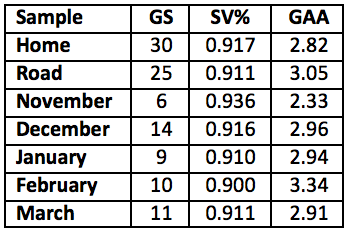How much of an upgrade could Mike Smith be?

When the Calgary Flames acquired Mike Smith from the Arizona Coyotes in June, it was heralded by some as a significant upgrade on what the team deployed between the pipes last season. While I don’t mind the acquisition and understand the rationale behind it, I’m also not expecting Smith to be a night and day upgrade on the tandem of Brian Elliott and Chad Johnson. However, I do think there are a few more subtle ways having Smith in the fold could help the Flames take a step forward in net.
Last month, I made the case keeping Elliott wasn’t a crazy idea based on the available options. Smith was one of those available options and I still think he and Elliott are comparable goaltenders. However, if Smith can tick three key boxes this season, he definitely has the chance to be a slight step up from what we saw during the 2016-17 season.
Consistency
Perhaps the most frustrating of Calgary’s goaltending struggles last season was the wild swings in form we saw. Elliott was scorching in the second half of the season but dreadful in his first few months with the Flames. Similarly, Johnson put together an elite run of hockey in November and December but was generally average the rest of the way. For Elliott, his season is easy to split into two halves, one good and one bad.

In that same vein, Johnson helped salvage the season with an incredible run starting with a win in Minnesota on Nov. 15 and carrying over into the middle stages of December. What followed from Johnson, though, made it hard for Calgary to justify giving him the type of money he got from Buffalo in free agency.

This is where Smith might be able to make some inroads. On a bad Arizona team, Smith’s splits were pretty steady over the course of the season and certainly didn’t have the wild swings like what we saw from Elliott and Johnson.

In the table above, I omitted October and April because Smith only played in four games combined those months. Regardless, you can see that of the three goalies in question, Smith was much more steady and consistent. The Flames ranked 21st last season with a 0.907 team save percentage, while Smith finished the year at 0.914. If he can stay steady and in around that number over the course of the coming year, it should improve Calgary’s fortunes slightly.
Workload
If Smith can pair the consistency discussed above while also taking the bulk of the starts this season, things will look even better for the Flames. One thing Elliott and Johnson haven’t been able to do over the course of their careers, last season included, is tackle the workload of a true number one. Smith, on the other hand, has proven he can do that, and at a high level.
Upon arriving in Arizona for the 2011-12 season, Smith has averaged 56 starts per season (prorating the shortened 2012-13 season to 58 starts). Compared to Elliott’s average of 44 over eight seasons (prorating 2012-13 to 34) and Johnson’s average of 29 over the last four years, Smith’s track record is clearly superior in this regard.
If Smith can make 55-60 starts this season and keep his save percentage in the range it was last year, all of a sudden this looks like a much more positive acquisition. Obviously there are no guarantees, but Smith’s ability in recent years to handle a number one workload is somewhat encouraging.
Carryover
Finally, Smith is going to have to carry his relative success from last season to his new team. On a very bad Coyotes team, Smith was one of the few bright spots and routinely kept games closer than they probably should have been. One piece of logic would suggest he stands to have at least the same amount of success playing behind a much better team. Of course, goaltending is finicky and that is only one school of thought, so by no means is that iron clad science.
On the encouraging side, though, was how well Smith performed with a heavy, heavy shot load. Arizona averaged 34.1 shots against per game last season, the second highest total in the league. Smith himself saw 33.1 shots against per night and many of those were of the 10-bell variety. According to NaturalStatTrick.com, the Coyotes allowed 844 high danger scoring chances last season, by far the most in the league. So not only was Smith’s nightly workload high, he was also facing extremely difficult shots on a regular basis. At 0.837, Smith’s high danger save percentage was among the league’s best, too.
Conclusion
While Smith had a fairly positive 2016-17 season in Arizona, he also missed time with injury for a second straight year. As such, he’s only started 87 games over the last two years, which calls into question slightly his ability to shoulder a big workload at this stage of his career. Now 35 years old, Smith is adamant any injury concerns are behind him, but it’s certainly something that lingers in the back of my mind heading into the season.
In saying that, though, Smith has the potential to give the Flames an upgrade between the pipes if a few of the boxes above are checked successfully. It’s a crapshoot to forecast if that’s going to happen with a new team, but it does allow for some optimism entering Smith’s first season in Calgary.
Recent articles from Pat Steinberg





